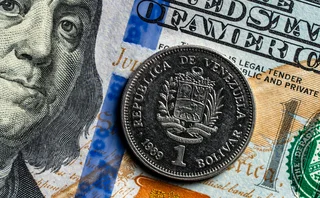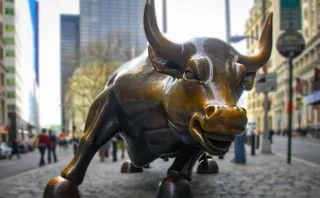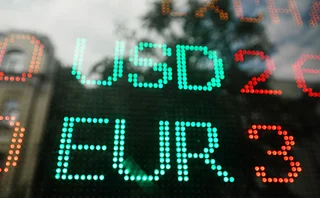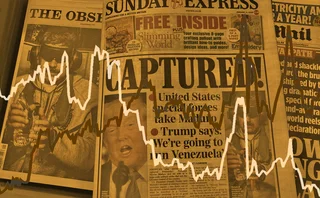
Sunk by correlation
Equity derivatives dealers faced a grim picture across global markets earlier this year, with steep rises in correlation and volatility together with a slump in dividend expectations decimating exotic books. How have dealers responded? By Mark Pengelly

Equity derivatives businesses have seen their revenues riven by losses during the first half of 2008. The malaise in credit, brought on by excessive US subprime mortgage losses, took hold of major equity markets earlier in the year. Subsequent spikes in volatility and correlation, combined with a drop in dividend expectations, have conspired to cause mark-to-market carnage for dealers' exotic books, which some estimate runs into billions of dollars.
"Everybody's looking at their exotic books. We've seen a whole series of two- and three-, if not more, standard-deviation moves. People never think the extreme moves are going to happen until they do," says Dan Fields, Paris-based global head of trading for equity derivatives and derivatives solutions at Societe Generale Corporate and Investment Banking (SG CIB).
Throughout most of December 2007 and into the beginning of January, 10-day historical volatility on the Dow Jones Eurostoxx 50 index drifted between 10% and 20%. But having been at 13.44% on January 17, volatility rocketed to a high of 62.89% on January 30. It subsequently receded to between 20% and 35% for much of February before spiking again to 39.43% on March 25.
Volatile markets usually make for trickier trading conditions - but crucially, this coincided with a sharp rise in correlation across global markets. Realised and implied correlations between global equity indexes, individual stocks and even between stock markets and some currency pairs have all soared. With most dealers short correlation as a consequence of popular structured products sold to retail and private banking clients, this delivered a painful blow to exotic books.
"It's not the products that are the most complicated from a financial-engineering perspective that would have caused most of the problems," says Neil McCormick, head of global equity exotics and hybrids at JP Morgan in London. "It would be those that have been around for many years, are high volume and have fairly low barriers to entry for a bank. The type of products would have been shorter-dated yield-enhancement products, typically with maturities between one and three years. They would involve people putting their principal at risk by selling options and trying to get coupons above the risk-free rate."
This encompasses products such as auto-callables, reverse convertibles and worst-of baskets. By referencing notes to baskets of stocks, investors are able to enhance coupons by taking a view on correlation. In the case of worst-of products, the payout is referenced to the worst-performing share in the basket. It is therefore beneficial when correlation is high and all stocks move in same direction, increasing the likelihood that the path of the worst-performing share is positive. The dealer, conversely, is short correlation.
The whipsawing in equity markets followed a widespread bull run in structured products issuance, which saw a flood of new players enter the market - many with little experience of handling unexpected spikes in correlation and volatility. Even for those that have experienced similar conditions in the past, the current dislocation has lasted longer than any previous disruption, says McCormick. "It's not the first time we've seen periods of high volatility and high correlation, but I think it's probably the largest and most prolonged move we've seen in those two parameters, and it's come at a time when the business is very much larger than it has been in the past," he says.
Pinning down the exact amount of dealer exposure to changes in equity correlation is not an easy task. Between single stocks and indexes, dealers reckon the size of correlation exposures stemming from bank exotic books to be anything from $200 million-500 million for every percentage-point change in correlation levels.
Unhappily for banks, shifts in correlation were exacerbated by frantic hedging activity, say dealers. Having traded below 50% in June 2007, implied correlation between the Nikkei 225 and S&P 500 indexes had hit 69% by June this year, according to Citi data.. Implied correlation between the Dow Jones Eurostoxx 50 and Nikkei 225 indexes had likewise inflated to 77% by June 2008, up from 59% a year previously.
With implied correlation soaring, many dealers were forced to re-mark their books and were left struggling to cover their positions. "People in the market have got the same exotic risks, so it becomes a crowded position, and when things are going badly there's nobody to step up and take the risk because everybody's got it and everybody's hurting," says McCormick.
Along with rising volatility and correlation, a third component added to the losses - dividends. Products such as reverse convertibles entail the investor implicitly selling out-of-the-money put options. This creates a long dividend position for the dealer - and the firm is increasingly long dividends as stock prices fall (Risk April 2008, pages 48-49). Again, dealers had the same positions - and as stock indexes fell in January, traders rushed to hedge their positions via dividend swaps, contributing to a sharp move in that market.
"If you go back six months, dividends used to move a few basis points per week or per month," says Alberto Cherubini, London-based head of exotic equity derivatives trading for Europe, the Middle East and Africa at Citi. However, the Dow Jones Eurostoxx 50 index dived by 17.54% between January 2 and January 23. Dividend yields on the index fell in tandem, dropping from approximately 4.1% to a low of around 3.7% during the week of January 21 - a 40bp move. "The market going down made several exotic desks much longer dividends. They would have chosen to sell dividends to cover their exposure, hence providing stronger supply, which crashed dividend levels," Cherubini adds.
Problem areas
Two particularly problematic areas for dealers have involved products referenced to baskets of financials, as well as those linked to the Nikkei 225 index. Before the onset of the credit crisis, investors were often eager to take exposure to financial stocks through products such as worst-of baskets due to the perceived strength of the financial sector and a succession of record profits. But realised correlation between bank stocks has heightened markedly since the turmoil began. The 90-day correlation of the Eurostoxx capitalisation-weighted index of European banks, for example, shot up from as little as 38% in July 2007 to almost 80% in September. It has remained above 60% for most of 2008.
A significant volume of notes referenced to the Nikkei 255 index, quantoed into local currencies, was also sold. These products required dealers to hedge both equity and currency risk, as well as volatility and correlation between the two. Implied correlation between the euro/yen exchange rate and the Japanese stock index has traded below 20% over recent years, but had ballooned to 54% by June 2008.
Equity derivatives dealers have been trying hard to adopt a more cradle-to-the-grave approach to their exotic book business in recent years. A search for effective products to lay off exotic book risks chimes with a growing enthusiasm among hedge funds, in particular, for non-directional trades that are little correlated with other, more traditional asset classes. More recently, these ideas have also garnered interest from institutional investors.
"If we can't find a hedge for certain exotic exposures, it means either it's a non-liquid risk and we're going to have to dramatically reduce that risk, or maybe it's at the wrong price. If it can't be traded, then it's not a viable long-term business," says SG CIB's Fields.
The French bank has used correlation swaps to lay off its correlation risk since 2002. These provide a much more effective way of buying back correlation from the market than other, more traditional methods of offloading correlation exposures - for instance, dispersion trades. In a dispersion trade, dealers would buy volatility on an index or basket of stocks through variance swaps or vanilla options, while selling volatility on the individual components. This leaves the bank short the volatility of stocks that outdo or underperform the index, and long correlation between them.
Correlation swaps, meanwhile, pay out a fixed strike per percentage point of realised correlation on a given portfolio. This kind of trade provides a purer play on correlation and a more durable hedge for exotic book risk than dispersion trades, dealers say. Nevertheless, some banks cite problems using these products to hedge exotic book exposures. Citi's Cherubini says correlation swaps have proved useful, without being a panacea. This is because structured products that involve selling options on baskets typically entail exposures to correlation and volatility, and not just correlation. "They are not exactly a perfect hedge for correlation that is being sold in the other products. If you sell an option on a basket to a customer, for example, you are selling covariance. If you then buy back realised correlation, clearly there is some mismatch."
This mismatch can result in dealers being short cross-gamma in some situations. Cross-gamma is the effect a change in the value of one underlying has on the delta of another. This may have caused further losses on hedges for dealers who believed their exotic book exposures were covered, thinks Yan Assoun, head of European equity derivatives trading at Credit Suisse. "The correlation swap has the potential to be short cross-gamma. In this sense, it's possible - and likely - that some of the hedges put on may have been difficult themselves."
Covariance shift
The shortcomings of correlation swaps have prompted a number of banks to begin trading covariance swaps over the past year. Although the product remains fairly illiquid, dealers say there are a handful of banks offering regular prices. These instruments pay out realised correlation multiplied by the volatility of two reference assets - making them more targeted towards specific dealer exposures and eliminating the problem of potentially being short cross-gamma. "It's a much more applicable hedge to the exposure that banks have sold," says JP Morgan's McCormick.
The covariance swap may be the best example of new thinking on exotic book hedges over the course of the past year, but dealers have been pushing plenty of other ideas as well. SG CIB, for instance, has been conducting dispersion trades with hedge funds, private banks and institutional investors via a product called Palladium since 2005. Palladium is essentially a three-year play on dispersion among five regional baskets of stocks. The product offers investors access to dispersion in a packaged format, and allows the French bank to offload some of its book axe positions. SG CIB would not disclose the volume of trades it has conducted, but Fields says it has become almost a flow product.
More recently, Credit Suisse has pioneered a geometric average-variance dispersion trade to offset some of its correlation exposures. "The geometric variance product is a way for us to cover some of our correlation exposures," says Assoun. In conventional arithmetic dispersion trades based on baskets of stocks or indexes, wildly outperforming equities can quickly come to dominate the basket or index in question. This can be particularly problematic in Asia, where poor liquidity can hinder those trying to cover volatility exposures on individual stocks.
The calculation method involved in the geometric average-variance trade eliminates this, ensuring all components of the basket or index retain an equal weighting, explains Assoun: "It addresses the problem of having a lot of positions accumulating in one specific stock. Especially in Asia, volatility is a relatively difficult thing to cover due to the liquidity of the market. If you do geometric dispersion, you don't have this result where one stock would take over the entire basket, so you're actually covering more of your correlation exposure," he explains.
The bank claims to have traded more than $1 billion of notional with hedge funds and prop desks in Asia. Assoun says it has conducted a smaller volume of trades in Europe, but aims to reach a target of around $500 million by the end of the year.
As well as the more sophisticated trades aimed at hedge funds and prop desks, banks have also been busily marketing correlation and dividend risk, in particular, to private banking and retail clients. Barclays Capital, for instance, has recently been pitching ideas that take advantage of imbalances in correlation and dividends. Hassan Houari, head of equity derivatives structuring at Barclays Capital in London, argues best-of baskets provide such clients with an opportunity to make money from current market dislocations. These products are essentially dispersion trades, as investors are betting one stock will outperform the rest of the basket. "When you talk about correlation swaps or covariance swaps to the most sophisticated investors, they know they are selling correlation. Investors in best-of products are unknowingly selling correlation," he says.
In April, Barclays Capital also launched a family of dividend swap indexes. They reference dividend swap curves for the Dow Jones Eurostoxx 50, FTSE 100, S&P 500 and Nikkei 225 indexes. Allowing investors to go long or short dividend swaps on the indexes with varying tenors, they provide the opportunity to take advantage of the recent sharp drop in dividend yields. "If you take analyst forecasts, you will see dividend growth is still about 4-6% a year. On the other hand, you have dividends implied by the interbank market pricing negative growth. You could argue there is, if not an arbitrage opportunity, at least good value in the current environment," says Houari.
By entering into dispersion trades, as well as correlation and covariance swaps, some hedge funds have lost out recently due to the same correlation and volatility moves that have affected banks. But dealers say some hedge funds have unwound trades as losses have escalated, leaving them once again facing unhedged positions. "The problem with doing trades with hedge funds is that if the mark-to-market is not going their way, they can quickly unwind the trade," says Wojtek Nabialek, head of structuring at BNP Paribas in London.
As a result, some participants stress the importance of tapping a variety of clients for book axe hedges. With pricing in covariance swaps having recently been stressed due to dealers running to hedge their exposures, BNP Paribas launched a fund enabling institutional investors to gain exposure to the instruments. Known as Global Synchro, the fund takes a short position in the covariance of global equity indexes via covariance swaps. To give investors greater comfort, the fund incorporates an additional risk management overlay of long volatility positions. Nabialek declines to say how much capital it has attracted, but claims it encompasses a significant portion of the French bank's covariance exposures. "We're trying to tap a longer-term client base with this kind of development," he adds.
Doubts
By using products such as these, many dealers insist a meaningful portion of their exotic book exposures have been successfully hedged. Indeed, a number of banks believe larger notional amounts of correlation risk are currently covered than ever before. But others are doubtful, arguing such coverage only extends to roughly 25% of dealer books. And some claim many market players have been happy to keep much of their correlation risk unhedged over the past few years. "Correlation has certainly been a major driver of profit and loss for the exotics desks of many banks recently," notes Cherubini of Citi.
Emmanuel Girod, global head of equity structured products trading at Merrill Lynch, thinks that despite product developments such as correlation and covariance swaps, most banks have recently carried much of their correlation exposure. "Most banks haven't really hedged their correlation exposures in the past few years because these positions were carrying well and had not been tested in a volatile environment."
These trades had previously yielded considerable profits for dealers. In the case of Nikkei quantos, correlation was often sold to clients at a premium, says Girod. "Traders were selling correlation between the Nikkei and dollar/yen at 20% or 30%, while it was realising at -20%," he adds.
Credit Suisse's Assoun agrees: "Some banks have decided to run through with their positions and keep the risk. But when you have a situation like the beginning of the year, when you saw a lot of banks running to cover their exposure, it can be costly to decide to just run it and hope that correlation will come down. It's a dangerous game."
After a period during which many dealers have been burnt for warehousing mountains of super-senior credit risk, some onlookers point to a similarity in the warehousing of exotic equity derivatives exposures. As with credit, there is no doubt among those in the market that banks will work harder to manage their positions in future. "Everybody in the market wants to do better at managing their risks, because everybody's had a bad time," says Girod at Merrill Lynch.
As a consequence, a number of banks are being far less aggressive in the equity structured products market. Some traders report clients are being much more careful too. "A lot of barriers have also been activated this year. If your barrier has been knocked in, you've probably lost a lot of money and you are probably thinking twice before deciding to come back to these products," adds Girod.
With equity markets down, many auto-callable investors will be facing extended product durations - with little prospect for issuers to coax them into buying new ones. Products such as reverse convertibles have also notably underperformed for many investors this year (Risk April 2008, pages 44-45). In a European equity research note published on May 7, JP Morgan analysts forecast European retail structured product issuance will fall 5-10% below 2006 levels by the end of this year. After recent dealer distress, this might be a blessing rather than a curse.
A sinking feeling
Most dealers that spoke to Risk admitted their books had suffered mark-to-market hits, but claimed they were better hedged than competitors. Some estimates of the total disclosed and undisclosed mark-to-market losses run into billions of dollars. But so far, BNP Paribas, Deutsche Bank and Societe Generale are the only large equity derivatives dealers to have publicly confessed to substantial balance-sheet haemorrhages as a result of market turmoil.
In its first-quarter results on April 29, Deutsche Bank revealed equity sales and trading revenues had dropped 57% compared with the first quarter of 2007, to EUR745 million. This figure also represents a 32% fall on the fourth quarter of last year. "Performance in equity derivatives was negatively impacted by the increased correlation between equity markets, which led to a deterioration in the value of residual derivatives positions arising from activities in European retail structured products," the bank said. Growth in cash equity revenues across Asia and North America had been "more than offset" by this decline, it added.
BNP Paribas' first-quarter results, released on May 14, reveal a steep plummet in equity revenues. In a statement, the French bank said this was due to the unexpected fall in dividends, erratic variations in volatility and very strong correlation between equity indexes and their underlying components. Equity and advisory revenues came in at EUR316 million - down 43% from the fourth quarter of 2007, and 61% from the first quarter of 2007. The drop appeared to be the main driver behind a slowdown in the corporate and investment banking unit's revenues from the fourth-quarter. However, overall revenues declined just 4.6% due to a pick-up in its fixed-income business.
Societe Generale's first-quarter results from May 13 also show a drop in the net banking income of its equities business. At EUR734 million, they fell 3% from the fourth quarter of 2007, and 31% from the first quarter of 2007. Again, the bank cited difficult market conditions, such as very high volatility and correlation.
Bankers suggest there could be further markdowns and losses to come. As one London-based exotics head puts it: "I'd be surprised if anyone's got out of this without a bloody nose, although maybe not any lost limbs."
Only users who have a paid subscription or are part of a corporate subscription are able to print or copy content.
To access these options, along with all other subscription benefits, please contact info@risk.net or view our subscription options here: http://subscriptions.risk.net/subscribe
You are currently unable to print this content. Please contact info@risk.net to find out more.
You are currently unable to copy this content. Please contact info@risk.net to find out more.
Copyright Infopro Digital Limited. All rights reserved.
As outlined in our terms and conditions, https://www.infopro-digital.com/terms-and-conditions/subscriptions/ (point 2.4), printing is limited to a single copy.
If you would like to purchase additional rights please email info@risk.net
Copyright Infopro Digital Limited. All rights reserved.
You may share this content using our article tools. As outlined in our terms and conditions, https://www.infopro-digital.com/terms-and-conditions/subscriptions/ (clause 2.4), an Authorised User may only make one copy of the materials for their own personal use. You must also comply with the restrictions in clause 2.5.
If you would like to purchase additional rights please email info@risk.net
More on Markets
How JPM AM swapped platforms for pipes
Asset manager wanted to cut FX venues – and their fees – out of dealer relationships. Now, it only trades direct
Keeping inflation markets open if government shuts down
Last year’s US government shutdown upset inflation trades; an Isda band-aid helped but a longer-term fix is needed
Brokers must shift HFT servers after China colocation ban
New exchange guidance drives rush for “proximity colo” in nearby data centres
LatAm FX carry trade shrugs off geopolitical fears
Clients in regional carry positions remain undeterred by US interventions, say dealers
S&P bull run drives interest in reset and lookback hedges
Variable strike put options proved popular alternative hedging format of 2025
US mutual funds slash short euro positions at record pace
Counterparty Radar: Pimco cut $4.6bn of EUR/USD puts in Q3 amid changing stance on dollar direction
Nomura hires new global eFX head
Mark McMillan to oversee e-trading and sales activities in newly created role
Trump’s LatAm gambit spurs FX hedging rush
Venezuela op boosts risk reversals as investors look to protect carry trades







